Shi Pu
Asynchronous Decentralized SGD under Non-Convexity: A Block-Coordinate Descent Framework
May 15, 2025Abstract:Decentralized optimization has become vital for leveraging distributed data without central control, enhancing scalability and privacy. However, practical deployments face fundamental challenges due to heterogeneous computation speeds and unpredictable communication delays. This paper introduces a refined model of Asynchronous Decentralized Stochastic Gradient Descent (ADSGD) under practical assumptions of bounded computation and communication times. To understand the convergence of ADSGD, we first analyze Asynchronous Stochastic Block Coordinate Descent (ASBCD) as a tool, and then show that ADSGD converges under computation-delay-independent step sizes. The convergence result is established without assuming bounded data heterogeneity. Empirical experiments reveal that ADSGD outperforms existing methods in wall-clock convergence time across various scenarios. With its simplicity, efficiency in memory and communication, and resilience to communication and computation delays, ADSGD is well-suited for real-world decentralized learning tasks.
Distributed Learning over Arbitrary Topology: Linear Speed-Up with Polynomial Transient Time
Mar 20, 2025Abstract:We study a distributed learning problem in which $n$ agents, each with potentially heterogeneous local data, collaboratively minimize the sum of their local cost functions via peer-to-peer communication. We propose a novel algorithm, Spanning Tree Push-Pull (STPP), which employs two spanning trees extracted from a general communication graph to distribute both model parameters and stochastic gradients. Unlike prior approaches that rely heavily on spectral gap properties, STPP leverages a more flexible topological characterization, enabling robust information flow and efficient updates. Theoretically, we prove that STPP achieves linear speedup and polynomial transient iteration complexity, up to $O(n^7)$ for smooth nonconvex objectives and $\tilde{O}(n^3)$ for smooth strongly convex objectives, under arbitrary network topologies. Moreover, compared with the existing methods, STPP achieves faster convergence rates on sparse and non-regular topologies (e.g., directed ring) and reduces communication overhead on dense networks (e.g., static exponential graph). These results significantly advance the state of the art, especially when $n$ is large. Numerical experiments further demonstrate the strong performance of STPP and confirm the practical relevance of its theoretical convergence rates across various common graph architectures. Our code is available at https://anonymous.4open.science/r/SpanningTreePushPull-5D3E.
HARE: HumAn pRiors, a key to small language model Efficiency
Jun 18, 2024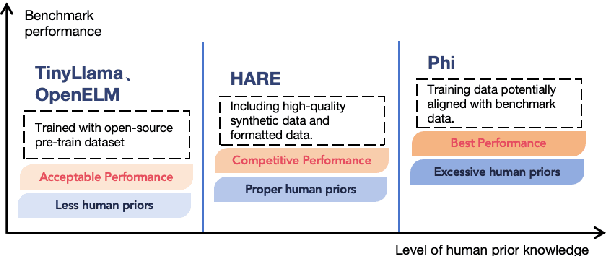


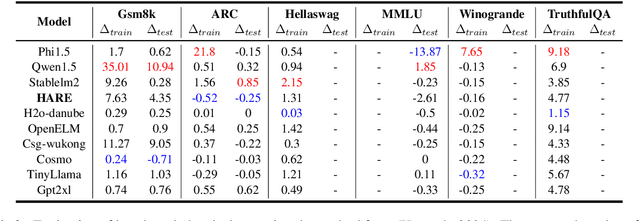
Abstract:Human priors play a crucial role in efficiently utilizing data in deep learning. However, with the development of large language models (LLMs), there is an increasing emphasis on scaling both model size and data volume, which often diminishes the importance of human priors in data construction. Influenced by these trends, existing Small Language Models (SLMs) mainly rely on web-scraped large-scale training data, neglecting the proper incorporation of human priors. This oversight limits the training efficiency of language models in resource-constrained settings. In this paper, we propose a principle to leverage human priors for data construction. This principle emphasizes achieving high-performance SLMs by training on a concise dataset that accommodates both semantic diversity and data quality consistency, while avoiding benchmark data leakage. Following this principle, we train an SLM named HARE-1.1B. Extensive experiments on large-scale benchmark datasets demonstrate that HARE-1.1B performs favorably against state-of-the-art SLMs, validating the effectiveness of the proposed principle. Additionally, this provides new insights into efficient language model training in resource-constrained environments from the view of human priors.
Distributed Random Reshuffling Methods with Improved Convergence
Jun 21, 2023Abstract:This paper proposes two distributed random reshuffling methods, namely Gradient Tracking with Random Reshuffling (GT-RR) and Exact Diffusion with Random Reshuffling (ED-RR), to solve the distributed optimization problem over a connected network, where a set of agents aim to minimize the average of their local cost functions. Both algorithms invoke random reshuffling (RR) update for each agent, inherit favorable characteristics of RR for minimizing smooth nonconvex objective functions, and improve the performance of previous distributed random reshuffling methods both theoretically and empirically. Specifically, both GT-RR and ED-RR achieve the convergence rate of $O(1/[(1-\lambda)^{1/3}m^{1/3}T^{2/3}])$ in driving the (minimum) expected squared norm of the gradient to zero, where $T$ denotes the number of epochs, $m$ is the sample size for each agent, and $1-\lambda$ represents the spectral gap of the mixing matrix. When the objective functions further satisfy the Polyak-{\L}ojasiewicz (PL) condition, we show GT-RR and ED-RR both achieve $O(1/[(1-\lambda)mT^2])$ convergence rate in terms of the averaged expected differences between the agents' function values and the global minimum value. Notably, both results are comparable to the convergence rates of centralized RR methods (up to constant factors depending on the network topology) and outperform those of previous distributed random reshuffling algorithms. Moreover, we support the theoretical findings with a set of numerical experiments.
Text-to-Image Diffusion Models can be Easily Backdoored through Multimodal Data Poisoning
May 07, 2023Abstract:With the help of conditioning mechanisms, the state-of-the-art diffusion models have achieved tremendous success in guided image generation, particularly in text-to-image synthesis. To gain a better understanding of the training process and potential risks of text-to-image synthesis, we perform a systematic investigation of backdoor attack on text-to-image diffusion models and propose BadT2I, a general multimodal backdoor attack framework that tampers with image synthesis in diverse semantic levels. Specifically, we perform backdoor attacks on three levels of the vision semantics: Pixel-Backdoor, Object-Backdoor and Style-Backdoor. By utilizing a regularization loss, our methods efficiently inject backdoors into a large-scale text-to-image diffusion model while preserving its utility with benign inputs. We conduct empirical experiments on Stable Diffusion, the widely-used text-to-image diffusion model, demonstrating that the large-scale diffusion model can be easily backdoored within a few fine-tuning steps. We conduct additional experiments to explore the impact of different types of textual triggers. Besides, we discuss the backdoor persistence during further training, the findings of which provide insights for the development of backdoor defense methods.
One Transformer Fits All Distributions in Multi-Modal Diffusion at Scale
Mar 12, 2023Abstract:This paper proposes a unified diffusion framework (dubbed UniDiffuser) to fit all distributions relevant to a set of multi-modal data in one model. Our key insight is -- learning diffusion models for marginal, conditional, and joint distributions can be unified as predicting the noise in the perturbed data, where the perturbation levels (i.e. timesteps) can be different for different modalities. Inspired by the unified view, UniDiffuser learns all distributions simultaneously with a minimal modification to the original diffusion model -- perturbs data in all modalities instead of a single modality, inputs individual timesteps in different modalities, and predicts the noise of all modalities instead of a single modality. UniDiffuser is parameterized by a transformer for diffusion models to handle input types of different modalities. Implemented on large-scale paired image-text data, UniDiffuser is able to perform image, text, text-to-image, image-to-text, and image-text pair generation by setting proper timesteps without additional overhead. In particular, UniDiffuser is able to produce perceptually realistic samples in all tasks and its quantitative results (e.g., the FID and CLIP score) are not only superior to existing general-purpose models but also comparable to the bespoken models (e.g., Stable Diffusion and DALL-E 2) in representative tasks (e.g., text-to-image generation).
Distributed Stochastic Optimization under a General Variance Condition
Jan 30, 2023Abstract:Distributed stochastic optimization has drawn great attention recently due to its effectiveness in solving large-scale machine learning problems. However, despite that numerous algorithms have been proposed with empirical successes, their theoretical guarantees are restrictive and rely on certain boundedness conditions on the stochastic gradients, varying from uniform boundedness to the relaxed growth condition. In addition, how to characterize the data heterogeneity among the agents and its impacts on the algorithmic performance remains challenging. In light of such motivations, we revisit the classical FedAvg algorithm for solving the distributed stochastic optimization problem and establish the convergence results under only a mild variance condition on the stochastic gradients for smooth nonconvex objective functions. Almost sure convergence to a stationary point is also established under the condition. Moreover, we discuss a more informative measurement for data heterogeneity as well as its implications.
CEDAS: A Compressed Decentralized Stochastic Gradient Method with Improved Convergence
Jan 14, 2023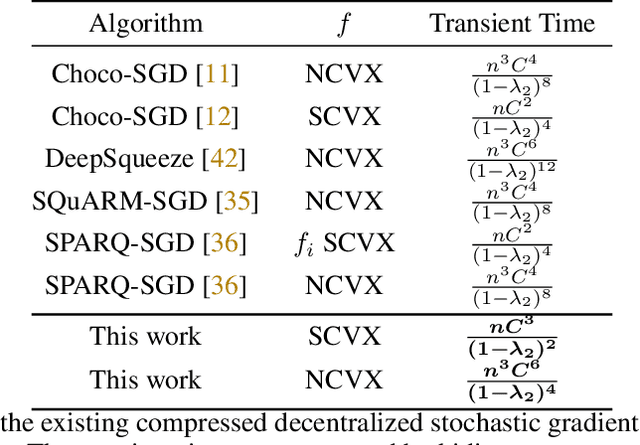

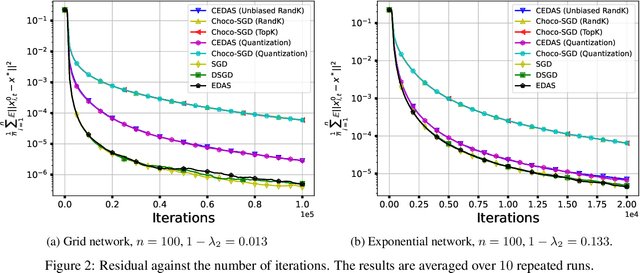
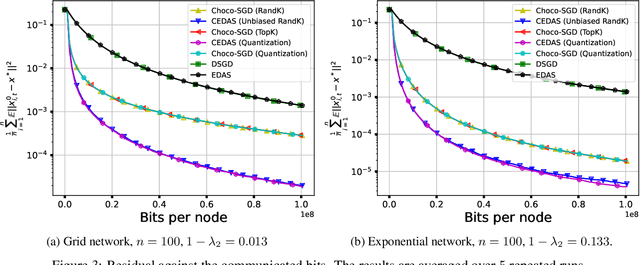
Abstract:In this paper, we consider solving the distributed optimization problem over a multi-agent network under the communication restricted setting. We study a compressed decentralized stochastic gradient method, termed ``compressed exact diffusion with adaptive stepsizes (CEDAS)", and show the method asymptotically achieves comparable convergence rate as centralized SGD for both smooth strongly convex objective functions and smooth nonconvex objective functions under unbiased compression operators. In particular, to our knowledge, CEDAS enjoys so far the shortest transient time (with respect to the graph specifics) for achieving the convergence rate of centralized SGD, which behaves as $\mathcal{O}(nC^3/(1-\lambda_2)^{2})$ under smooth strongly convex objective functions, and $\mathcal{O}(n^3C^6/(1-\lambda_2)^4)$ under smooth nonconvex objective functions, where $(1-\lambda_2)$ denotes the spectral gap of the mixing matrix, and $C>0$ is the compression-related parameter. Numerical experiments further demonstrate the effectiveness of the proposed algorithm.
Alignment-Uniformity aware Representation Learning for Zero-shot Video Classification
Mar 29, 2022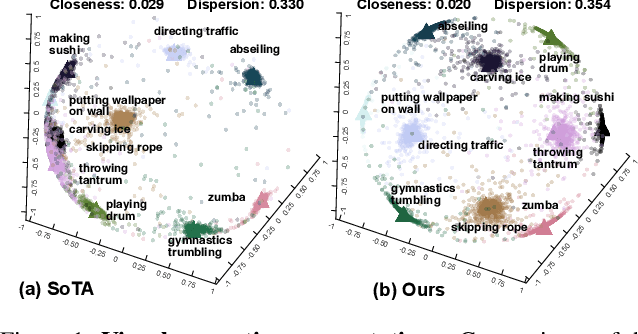

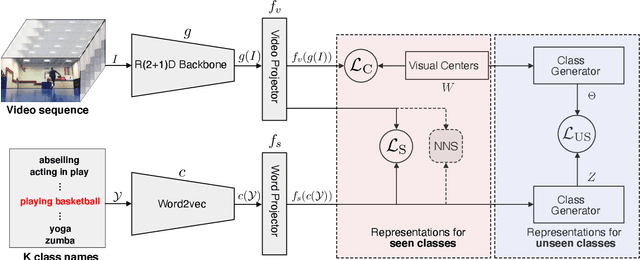
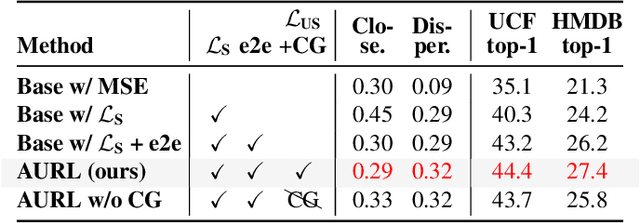
Abstract:Most methods tackle zero-shot video classification by aligning visual-semantic representations within seen classes, which limits generalization to unseen classes. To enhance model generalizability, this paper presents an end-to-end framework that preserves alignment and uniformity properties for representations on both seen and unseen classes. Specifically, we formulate a supervised contrastive loss to simultaneously align visual-semantic features (i.e., alignment) and encourage the learned features to distribute uniformly (i.e., uniformity). Unlike existing methods that only consider the alignment, we propose uniformity to preserve maximal-info of existing features, which improves the probability that unobserved features fall around observed data. Further, we synthesize features of unseen classes by proposing a class generator that interpolates and extrapolates the features of seen classes. Besides, we introduce two metrics, closeness and dispersion, to quantify the two properties and serve as new measurements of model generalizability. Experiments show that our method significantly outperforms SoTA by relative improvements of 28.1% on UCF101 and 27.0% on HMDB51. Code is available.
Distributed Random Reshuffling over Networks
Jan 09, 2022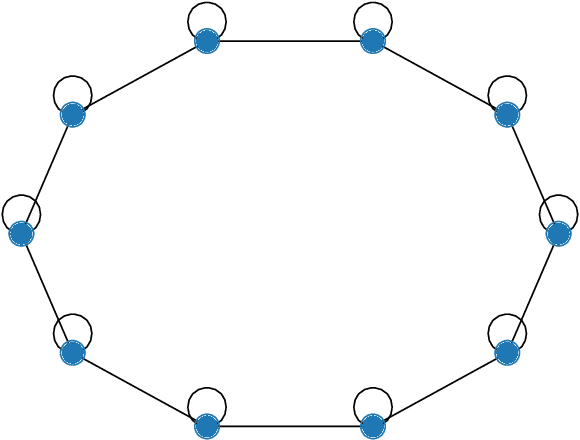
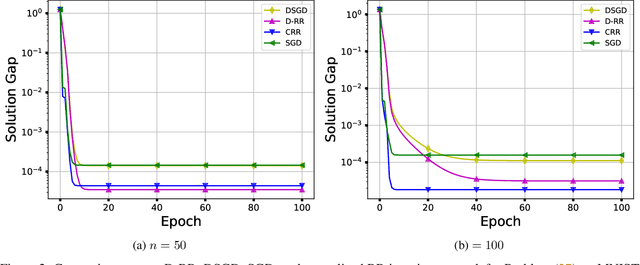
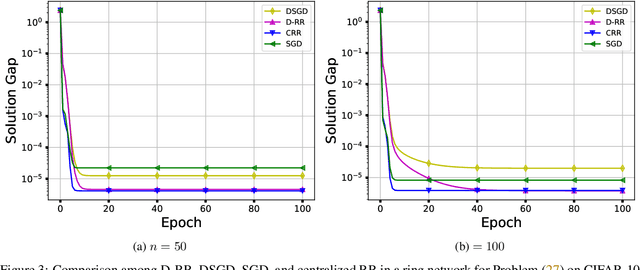
Abstract:In this paper, we consider the distributed optimization problem where $n$ agents, each possessing a local cost function, collaboratively minimize the average of the local cost functions over a connected network. To solve the problem, we propose a distributed random reshuffling (D-RR) algorithm that combines the classical distributed gradient descent (DGD) method and Random Reshuffling (RR). We show that D-RR inherits the superiority of RR for both smooth strongly convex and smooth nonconvex objective functions. In particular, for smooth strongly convex objective functions, D-RR achieves $\mathcal{O}(1/T^2)$ rate of convergence (here, $T$ counts the total number of iterations) in terms of the squared distance between the iterate and the unique minimizer. When the objective function is assumed to be smooth nonconvex and has Lipschitz continuous component functions, we show that D-RR drives the squared norm of gradient to $0$ at a rate of $\mathcal{O}(1/T^{2/3})$. These convergence results match those of centralized RR (up to constant factors).
 Add to Chrome
Add to Chrome Add to Firefox
Add to Firefox Add to Edge
Add to Edge